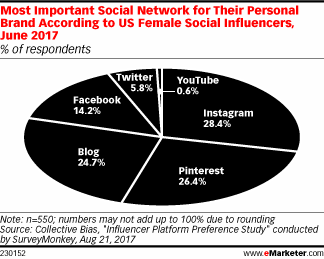But visual channels score well, study finds
Snapchat has obsessive teen users and a growing millennial user base, but one group seems to be resistant to its charms so far: female influencers.
In June, influencer-focused content marketing company Collective Bias polled its stable of largely female influencers to get a sense of their preferred social networks. (Collective Bias said it selected influencers for inclusion in its network based on “authenticity and original content,” but did not require that they meet a specific average number of followers on various social media platforms.)
The company found that Snapchat wasn’t considered the most important social network by any of them. Instead, Instagram topped the list, deemed invaluable by 28.4% of those polled. Pinterest also factored strongly in the survey results, named as the most important social media platform by 26.4% of respondents. Less visually-focused services like Facebook and Twitter fared less well.
The reason for Snapchat’s poor showing among influencers may lie in its very DNA. Unlike Instagram, which allows for the broadcast of content among a coterie of both followers and mere browsers of the platform, Snapchat was originally designed to let users target a narrow group of select recipients with ephemeral content.
As a result, it may not lend itself well to the type of content marketing model used by successful influencers on Instagram, who have figured out how to earn income by getting products and brands in front of as many people as possible. Instead, Snapchat relies on maintaining its air of exclusivity and a target user base that leans heavily toward the young. eMarketer estimates that 78.7% of the service’s US users are ages 12 to 24, with 18- to 24-year-olds accounting for the largest chunk of users, at 30.8%.
Whether deserved or not, Snapchat has built a reputation for discouraging the influencer model on its platform, perhaps out of concerns that a deluge of content originating with brands could damage its own reputation among younger users craving a more personalized experience. In practical terms, that’s translated to the firm reportedly trying to channel most marketing through its branded Snapchat Stories offering.
But that may be changing. In August, Digiday reported that Snapchat had begun extending its verified feature beyond pop culture celebrities to include influencers with significant followings. In addition, it started allowing these influencers to use its Official Stories feature, something once reserved solely for more widely-known public figures.
Still, Snapchat will have some catching up to do. Collective Bias found that Instagram Stories, carousel albums and Instagram Live made up three of the top four social network features regularly used by the influencers it polled.
by Rahul Chadha


